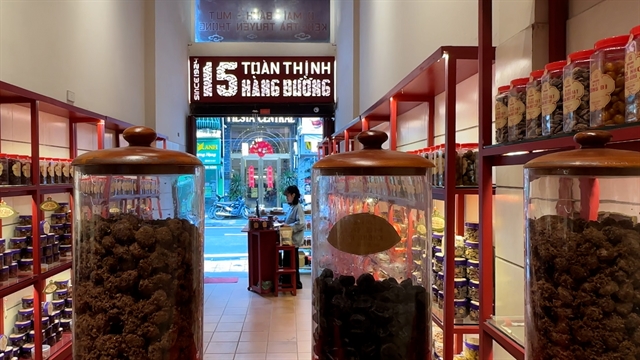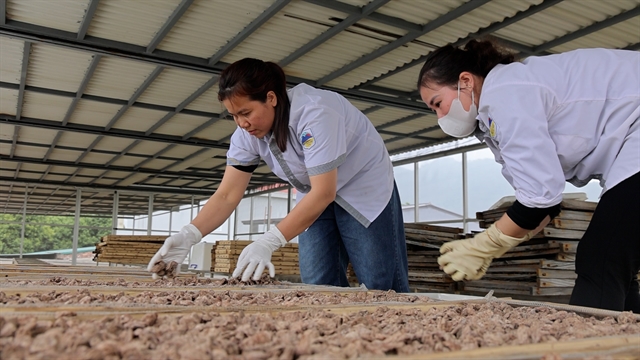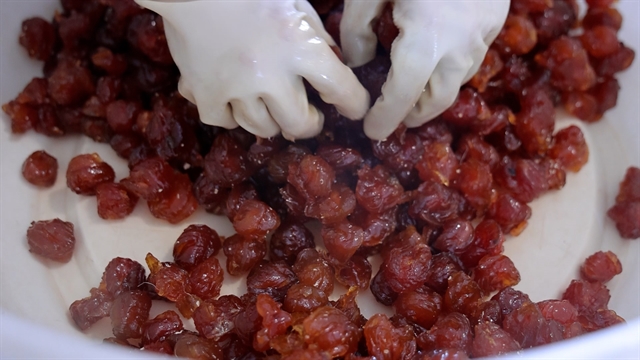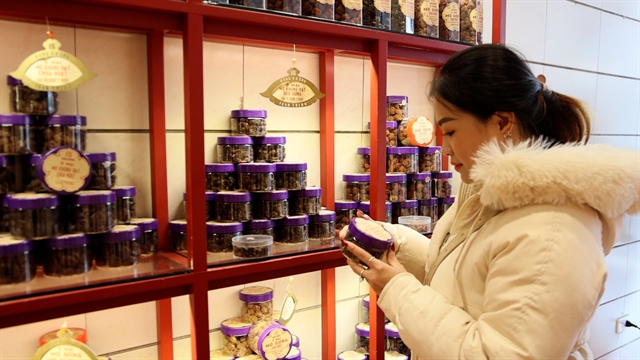For locals and tourists alike, Hà Nội's Hàng Đường Street is a place where the art of preserving fruits is not only a business but a cultural experience.
By Lê Hương
(additional interview by Hải Anh)
In the heart of Hà Nội’s bustling downtown lies Hàng Đường Street, which is renowned for its long-standing tradition of making fruit preserves, jams, and sweets. For locals and tourists alike, the street is a place where the art of preserving fruits is not only a business but a cultural experience.
The street displayed dozens of brands that specialise in the treats, yet one name stands out among them - Toàn Thịnh.
This family-owned business has earned a place in the hearts of many, becoming one of the most beloved names in making dried fruit. The story of Toàn Thịnh spans more than a century, passed down from one generation to the next.
When Toàn Thịnh began, their offerings were simple - a few types of dried fruit preserved with natural ingredients.

SHOPPING: The shop has been popular among both locals and tourists. VNS Photo Hải Anh
Over the years, the family has perfected their craft. Today, they have expanded their offerings to include a staggering variety of 170 kinds of dried fruit and jams, a testament to their commitment to innovation while respecting traditional methods.
At the heart of Toàn Thịnh’s success is a deep commitment to quality.
Lê Lương Ngọc, the fourth-generation owner of the brand, explained in a recent interview with Việt Nam News: "Quality is our priority. We continue to use traditional methods to preserve fruits. Our fruits aren’t dried with electric dryers but naturally in the wind. We have the proper facilities to dry the fruits, which allows them to dry naturally while maintaining a soft moisture.”
This careful approach ensures that each kind of fruit retains its natural flavour, texture, and nutrients, standing in contrast to the mass-produced alternatives often found in supermarkets.
In the past, dried fruits were not just tasty snacks; they were also valued for their medicinal properties.

FRUITS OF THEIR LABOUR: The workshop has proper facilities to wind-dry fruits.
Before the advent of refrigeration, people used sugar, salt, and sometimes ginger to preserve fruits, ensuring they could be enjoyed even when fresh produce was not available.
The most commonly preserved fruits were often lemons, apricots, and plums – fruits that could withstand the preservation process and retain their distinctive flavours over time.
Lê Thị Tân, the third-generation member of Toàn Thịnh, underlined the importance of getting the balance just right.
"When we eat a dried fruit and keep the nut in our mouth, we can still taste the sour and sweet flavours lingering for a long time,” she said.
“If the fruits weren’t soaked long enough in salt and sugar, we might taste the nut as salty. Every part of the process needs to be done with great care and cleanliness.”

SNACK TIME: Lê Thị Tân does the final touch for some preserved fruit.
This attention to detail is what makes the preserved fruits of Toàn Thịnh a truly unique culinary experience.
Over recent years, as the business has expanded, Toàn Thịnh has adapted to changing tastes, particularly among young customers.
While the traditional methods remain unchanged, the variety of dried fruit and jams offered has grown to include new flavours that appeal to present-day preferences.
"Each season, the taste of natural fruits changes," Ngọc said.
"Weather also plays a significant role, so we don’t rely on a fixed recipe. An experienced processor adjusts the taste of the fruit, sugar and salt to ensure the final product is perfect - something that an industrial processing line can't replicate.”
This adaptability is key to the brand’s continued success, ensuring that each batch is made to perfection, reflecting the natural conditions of a particular year.

DRIED FRUIT: The shop's bestselling products include dried longan.
Though much of the preserved fruit-making process can be automated, certain stages require hands-on care and expertise.
Ngô Thị Hiền, a worker at Toàn Thịnh, elaborated on the meticulousness of the process: "We mainly process apricot, plum and dracontomelon. We mince ginger and mix it with salted or sweetened apricot. The final product is ready only after nearly a year of preservation.”
“The ideal taste should perfectly balance sweet, spicy, salty, and sour," she said.
Despite not advertising their products on online platforms or using social media to market their goods, Toàn Thịnh enjoys a loyal and ever-growing customer base. Their regulars value the authenticity and quality of the dried fruit.
Nguyễn Thanh Hồng, a visitor from Hồ Chí Minh City, said: "For the past six years, I’ve come here every time I visit Hà Nội. The preserved fruits here are the best - delicious with a perfect blend of sour, sweet, and just the right amount of saltiness."

BROWSING: Customer Nguyễn Thanh Hồng from HCM City has often bought gìfts at the shop for her family members and friends.
The Toàn Thịnh family's devotion to preserving this craft honours their ancestors and provides future generations with a taste of Hà Nội’s rich cultural heritage.
As Hà Nội continues to grow and modernise, the Toàn Thịnh family remains steadfast in their commitment to tradition, ensuring that the art of preserving fruit, and the unique flavours they produce, will endure for many generations to come.
This dedication to quality and tradition has solidified their place as one of the most cherished food brands in Hà Nội, and their story is a beautiful reminder of the importance of preserving both heritage and flavour. VNS